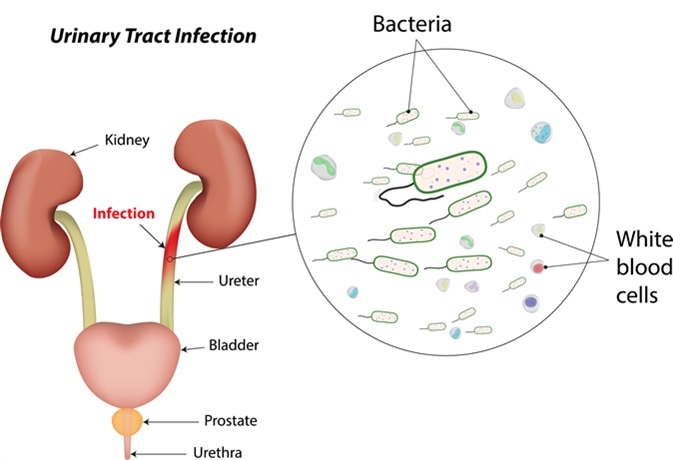Studies have found that 2 out of 100 boys and 8 out of 100 girls are at risk of developing urinary tract infections (UTIs). In general, bacteria are not found in the urinary tract. However, some factors make it easy for the bacteria to enter and stay in the urinary tract. When bacteria found on the skin, especially near the anus and vagina, enter the kidneys or urinary bladder, they cause infection in the urinary tract.. Eating healthy and preventing dehydration is essential for bladder health.

Urinary Tract Infection. Image Credit: joshya / Shutterstock
Causes and Symptoms
Compared with adults or older children, young children are at a greater risk of kidney damage due to UTIs. Infants who are less than a year old are most likely to be affected by UTIs.
During the initial few months of life, the prevalence of UTI is more in boys than in girls. One year after birth, however, the prevalence of UTI is higher in girls than in boys and the risk continues to increase among girls from childhood to adolescence.
In general, UTI may be divided as 1) upper UTI and 2) lower UTI. When the infection is in the kidneys or in the ureters, then it is referred to as an upper UTI. When the infection is diagnosed in the bladder or urethra, then it is referred to as a lower UTI.
UTIs in young children are generally asymptomatic; sometimes, symptoms, such as fever, vomiting, or reduced appetite, may be seen. The infection usually occurs in the bladder. On an average, 3 out of 100 children present with UTI.
In children with bladder infection, urine may appear cloudy and mixed with blood, together with a strong odor. Children may urinate frequently, and during urination, they may feel a burning sensation. They may experience malaise and pain or pressure in the lower back or pelvis. Even after being toilet-trained, children with UTI may experience urinary incontinence.
If a child has symptoms, such as fever, shaking, chills and intense pain in the back or flank, along with vomiting and nausea, then one may suspect pyelonephritis, which is a serious complication of upper UTIs.
In children with normal anatomy and physiology of the urinary system, urine does not flow back to the ureter, whereas in children with vesicoureteral reflux (VUR or reflux) and birth defects that cause reflux, urine flows backward towards the kidneys from the bladder. These children are at a greater risk of developing UTIs.
Urinary Tract Infections in Children (UTIs)
Tests and Diagnosis
Analysis of urine samples helps to diagnose UTIs. For children who are toilet-trained, urine is collected using a collection bag or a suprapubic collection method. A catheterized specimen urine culture may also be used. The collected sample of urine then undergoes a series of microbiological tests.
During the first occurrence of the infection, imaging tests are performed to find out the root cause. These tests also detect any damage that is caused to the kidneys. Typical tests include kidney ultrasound and X-rays. X-rays are taken when the child urinates; techniques, such as voiding cystourethrograms (VCUGs), are used to view the urinary bladder when a child shows signs of urinary system dysfunction.
Physicians take into account several factors, such as the age of the child, other relevant case-specific history (as test follow-up is often required for young children), intensity of the infection and its response to the treatment procedure, as well as any other medical conditions or physical defects that the child may have, before deciding on a special study.
Treatment and Prevention
Once children are diagnosed with a UTI, treatment should be provided immediately. This will help protect the kidneys. Contacting a specialist-physician is recommended when the child is less than 6 months old or if the child has other problems. Young babies are usually hospitalized; antibiotics are given through the veins. Older babies and children take antibiotics orally or visit the hospital for treatment.
While undergoing treatment a child should drink more fluids. When the child has medical conditions such as VUR or recurrent UTIs, antibiotics are prescribed for 6 months or even up to 2 years. After completing the treatment, a follow-up visit is required. Another urine test may be done to check whether any bacteria are still present inside the bladder.
Avoiding bubble baths, increasing fluid intake, encouraging the child to wear loose-fit clothes and to urinate several times, as well as training to clean genital area for reducing bacterial spread, are some of the UTI preventive techniques. Physicians may prescribe a low dose of antibiotics after the child is cured of first symptoms; this helps in preventing relapse of infection.
Further Reading